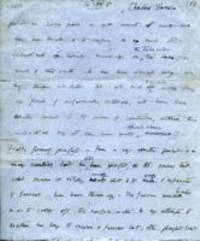- Browse Repository
- College of Arts & Sciences
- CWRU Dittrick Medical History Center
- Earthworms (x)
- Robert M. Stecher Collection of Darwiniana
Robert M. Stecher Collection of Darwiniana
Show moreManuscript pages from Vegetable Mould and Earthworms (p. 292, 1.2 to p. 293, 1.3 in 1881 edition). Text revised slightly in published edition. Transcription: "c. 1880 Charles Darwin period as 2000 years a great amount of Earth will have been brought to the surgace on most old embankments of tunnels, especially on [], + most of this Earth will have been washed away. We may, therefore, conclude that all such ancient works, when not formed of [] materials, will have been [] [] in the course of centuries, although their inclination may not have been greatly []. Fields [] ploughed - From a vy remote perioud + in many countries land has often been ploughed, so the [], called [] or [], usually about 8 ft across, + [] by furrows, have been thrown up. [] so as to carry off the surgace water. In my attempts to ascertain how long the [] + furrows last, after [] land has been [] in [], obstacles of many kinds were encountered. It is rarely known when a field was last ploughed; + some fields which were thought to have been in [] for time immemorial were afterwards found to have been ploughed only 50 or 60 years before. [] the easy fast embankment or tumulus 2000 years old would if it were not removed have raised about 200 times through the intestines of [], + thus have been brought to the surface. As on each occasiona the castings in their soft condition would be eminently liable to be washed to a lower level, it is impossible to doubt that all ancient embankments and tumuli must in the course of centuries have been somewhat lowered though their slopes may not be greatly altered."
The Robert M. Stecher Collection of Charles Darwin Books and Manuscripts
Show less

